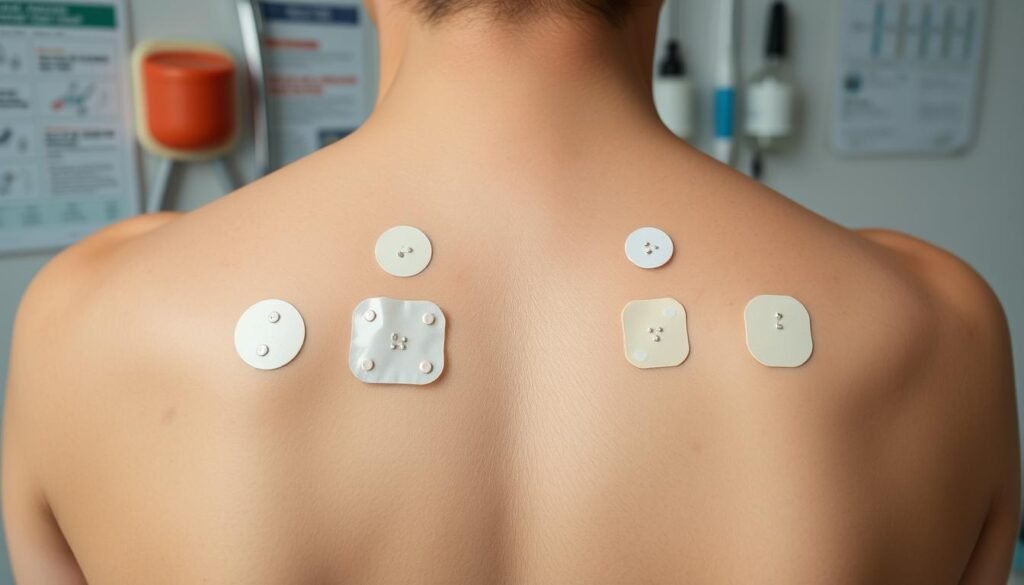Did you know that 70-80% of people with allergic contact dermatitis find their triggers through patch testing? This method is key in figuring out this common skin issue. It leads to swelling because of contact with irritants or allergens. Contact dermatitis impacts up to 15% of people at some time, showing the need for effective testing.
Dermatologists start the diagnosis with a full check-up. They look at symptoms and the patient’s history. Since contact dermatitis can greatly affect life quality, knowing how it’s diagnosed is crucial. Patch testing uses about 20-30 allergens over three days. It is the best way to find out which substances cause reactions.
Key Takeaways
- Patch testing is crucial for identifying allergens in contact dermatitis cases.
- The testing process generally spans over 96 hours across three days.
- Not all patients will test positive, suggesting alternative causes for their dermatitis.
- The average success rate for identifying triggers is between 70-80%.
- Patch testing significantly improves symptoms in about 90% of patients after diagnosis.
- Skin tests are safe for all age groups, including infants.
Understanding Contact Dermatitis
Contact dermatitis makes skin inflamed when it touches certain substances. Knowing about this condition is key to diagnosing it correctly. It mainly happens in two ways: allergic reactions and irritant reactions. Allergic reactions are immune system responses that happen later. Irritant reactions, which are more common, don’t involve the immune response. They happen in about 80% of cases.
Many workers get affected by contact dermatitis. According to a survey, there are about 1,700 cases for every 100,000 workers in a year. This is seen a lot in fields like mining, manufacturing, and healthcare. Hands are the most affected part, with 64% of allergic cases and 80% of irritant cases.
Knowing about skin allergies helps in treating them. More than 3,700 allergens are known, with nickel, fragrances, and neomycin being common. Cell phone users and hairdressers often get nickel reactions on their faces. About 10% of people with eczema react to fragrances. This shows how various everyday items can cause allergies.
People can become sensitive to allergens after being exposed many times. Even a small amount can cause a reaction. Early spotting and managing is crucial. Solvents, rubber, and detergents are usual irritants. Jobs like cleaning, cooking, and healthcare have a higher risk. Taking steps to avoid contact dermatitis is important for skin health.
| Type of Reaction | Mechanism | Common Allergens |
|---|---|---|
| Allergic Contact Dermatitis | Delayed hypersensitivity response | Nickel, Fragrance mix, Neomycin |
| Irritant Contact Dermatitis | Skin barrier damage | Solvents, Detergents, Rubber |
Understanding the complex nature of contact dermatitis is key. It leads to better diagnosis and treatments. This improves the lives of those affected.
Types of Contact Dermatitis
Contact dermatitis splits into two kinds: irritant contact dermatitis and allergic contact dermatitis. Each varies in causes and signs. These differences help doctors pinpoint allergic dermatitis.
Irritant contact dermatitis is the more common form. It happens when skin touches irritating stuff like soap or chemicals. This kind affects many workers, especially those handling dangerous substances daily. It’s often seen in women, kids, older people, and those already prone to skin issues.
Allergic contact dermatitis impacts around 20% of kids. It comes from allergens like poison ivy or certain metals. People have to be exposed once before reactions kick in. Symptoms, such as red patches or severe itching, can appear one to two days after contact.
Knowing these categories helps in correctly diagnosing allergic dermatitis. Early identification allows for the right treatment. This can lead to better recovery for anyone dealing with these skin problems.
| Type of Dermatitis | Causes | Common Symptoms | Demographics Affected |
|---|---|---|---|
| Irritant Contact Dermatitis | Soaps, solvents, friction | Redness, itching | Common in women, infants, the elderly |
| Allergic Contact Dermatitis | Allergens (e.g., poison ivy, metals) | Rash, hives, blistering | Affects approximately 20% of children |
Symptoms of Contact Dermatitis
Contact dermatitis symptoms can greatly disrupt everyday life. Itching usually starts things off, then the skin turns red and irritated. If it gets worse, the skin might blister, dry up, or crack. How severe these symptoms get varies from person to person, depending on their skin and what they’ve touched.
People with lighter skin tend to see redness first. But if you have darker skin, you might see it turn dark brown, purple, or gray instead. How fast these symptoms show up is also key for figuring out if it’s dermatitis. Sometimes, you might see a reaction in a few hours, or it could take up to ten days.
Common symptoms of skin allergies linked to contact dermatitis are:
- Itching
- Swelling
- Bumps or blisters with clear liquid
- Hot or tender skin
Allergic contact dermatitis isn’t as common as the irritant kind. It can be set off by various products, from beauty items to metals like nickel. Even certain fruits and veggies can spark surprising reactions, highlighting the importance of knowing what you eat. In contrast, irritant contact dermatitis often comes from using soaps, detergents, or being in water too long.
The hands and face usually suffer the most since they touch many things every day. Both pharmacists and doctors are crucial in spotting and treating these issues. They often suggest applying emollients to keep the skin moist and using topical corticosteroids to reduce swelling.
Knowing these symptoms of skin allergies helps with fast identification and care. It also teaches you to avoid known irritants and allergens, preventing more flare-ups.
The Importance of Accurate Diagnosis
Getting the right diagnosis is key to treating contact dermatitis. If doctors get it wrong, treatments won’t work well, causing more discomfort. Doctors need to look at the patient’s history, do physical exams, and sometimes lab tests to find the right answer.
About 74% of contact dermatitis cases come from irritants. Knowing this is crucial. If the cause is wrong, the suffering continues. There’s a lot to know about allergic reactions and irritants. Doctors must understand it all.
A lot of people, maybe 25% to 30%, react to common things like nickel or fragrances. If not diagnosed right, these allergens keep causing problems. Jobs like hairstyling and healthcare see nearly half of such cases due to workplace exposure.
Diagnosing correctly also means picking the best treatment. Some meds, like prednisone, work fast in 12 to 24 hours. Others, like methotrexate, are for long-term problems. Treatments like phototherapy focus on specific triggers.
To manage contact dermatitis well, knowing the differences is key. A right diagnosis stops more issues. Healthcare pros can really improve life quality by understanding each patient’s unique case.
| Diagnosis Method | Purpose | Common Findings |
|---|---|---|
| Patient History | Identify previous exposures and allergies | Allergic reactions, irritant exposure |
| Physical Examination | Assess symptoms and skin condition | Rashes, inflammation, redness |
| Laboratory Tests | Confirm allergies and irritants | Patch test results, allergen identification |
In summary, diagnosing contact dermatitis right is super important. It doesn’t just influence treatment. It also helps with the patient’s money, work-life, and finding the best way to manage their condition.
How Contact Dermatitis Is Diagnosed
A dermatologist starts diagnosing contact dermatitis by examining the patient closely. They look at the patient’s health history and current symptoms. It’s important to consider when the rash happened and what might have caused it. Knowing if the rash is due to an allergy or irritant helps choose the best treatment.
Initial Assessment by Dermatologists
Dermatologists first look at the skin closely. They search for signs like redness, swelling, or blisters to find allergic reactions. Questions about the rash’s cause and known allergies are asked. This step is crucial for deciding on a treatment.
Patient History and Symptoms Review
Getting a detailed patient history is critical for diagnosing dermatitis. Dermatologists ask about work, use of products like cosmetics, and where the person has been. This helps find what caused the dermatitis. Understanding the cause leads to better treatment.
The Role of Patch Testing
Patch testing is key in finding out which allergens cause skin reactions. Dermatologists use it to see what causes a patient’s skin problems. This helps them make a treatment plan just for them.
What is Patch Testing?
An allergy patch test checks how someone reacts to different allergens. Small amounts of these allergens go on the skin, usually the back, and stay covered for 48 hours. This checks for any skin reactions. Patch testing can find one or many allergens with its detailed method.
Why Patch Testing Is Essential
Patch tests are crucial for finding out about allergic contact dermatitis in around 70% of cases. They use standard panels to check for common allergens. For instance, nickel sulfate is found in 18.5% of positive tests. Skin patch tests can find 76% more positive reactions than older tests. This process is simple but needs skilled interpretation.
Doctors pick allergens based on a patient’s job, things they’ve been around, and what they use. This customized test not only helps understand current symptoms but also past and future skin issues.

| Allergen | Positive Reaction Rate | Reaction Type |
|---|---|---|
| Nickel Sulfate | 18.5% | Common metal allergen |
| Balsam of Peru | Varies | Fragrance allergen |
| Fragrance Mix I | Varies | Fragrance allergen |
| Fragrance Mix II | Varies | Fragrance allergen |
| Other allergens | Standard panel (65 allergens) | Various |
Reviewing resources like different types of eczema helps understand eczema better. This includes how patch testing helps find what causes allergic reactions. It leads to better treatment for patients.
What to Expect During Patch Testing
Patch testing is important for figuring out allergic contact dermatitis. Knowing what happens during this process can make you feel more comfortable. To get the best results from patch testing, being ready is key.
Preparation for the Test
Preparing for patch testing is a must. You should not use any creams on your back before the test. Staying out of the sun and not sweating a lot are also good ideas. These steps ensure the test can accurately identify what you’re allergic to.
The Testing Process Explained
The test starts by putting patches with allergens on your skin, usually the upper back. You keep these patches on for 48 hours. This lets the allergens touch the skin properly.
After taking the patches off, a doctor checks your skin for reactions. You might need a second check 2 to 5 days later if they’re not sure. This detailed process helps understand allergies to things like Nickel and Fragrances better. To learn more, check preparing for allergy testing.
Common Allergens Identified Through Patch Testing
Patch testing is key to finding skin allergies. It highlights specific allergens behind contact dermatitis. Often, these allergens are metals like nickel and cobalt, along with fragrances and preservatives in many personal care items.

The North American Baseline Series has 50 allergens, sometimes going up to 80. This list includes things like potassium dichromate, p-Phenylenediamine, and neomycin sulfate. Knowing these allergens helps doctors make plans to avoid them.
Geography matters when looking at skin allergies. For example, the European series includes allergens like lanolin alcohol and fragrances. Patch testing picks allergens carefully, using concentrations from 0.1% to 30%. This reduces the chance of incorrect results.
After finding the allergens, patients learn to avoid them. Dermatologists guide them on product ingredients and changing their surroundings. This helps patients keep their skin healthy and avoid future issues.
For more info, check out this article on the importance of patch testing for allergens.
Interpreting Patch Testing Results
After patch testing, dermatologists look at how the skin reacted to various allergens. They use a scale from negative to a +++ strong positive reaction. Knowing how to read interpreting allergy test results helps patients and doctors decide what to do next.
A positive test can mean different things. It could show a current, past, future, or uncertain reaction. Sometimes, it finds allergies we didn’t know about. This might lead to more tests or changes in life to avoid these allergens.
The skin might show redness, bumps, slight swelling, or blisters. A negative doesn’t mean you’re clear of contact dermatitis. It just means you’re not sensitive to what you were tested for. Knowing how to read the results is crucial. It shows what to stay away from to stop flare-ups and manage symptoms. Look at Understanding patch test outcomes for more details.
Patch tests are key for finding what causes allergic reactions for many people. It could be metals, perfumes, or preservatives. With the right reading of results, patients and health experts can make plans. These plans help lessen and control dermatitis.
Management and Treatment After Diagnosis
After finding out you have contact dermatitis, it’s key to manage it well. This helps lessen symptoms and betters your life. Avoiding identified allergens is a big part of control. You’ll need to keep away from triggers to cut down on outbreaks. Making changes in your life helps, too. Use products that won’t cause a reaction. Also, test new products on your skin before full use.

There are many ways to treat dermatitis symptoms. Topical steroids are often used for their power to lower inflammation. They come in various forms to fit different needs. Sometimes, antihistamines are given to ease itching. And, creams like pimecrolimus and tacrolimus work well for many types of dermatitis.
In tough cases, doctors might suggest systemic steroids. But, they think carefully about this due to possible side effects. Phototherapy is another path for hard-to-treat cases. Working with your healthcare team to make a plan just for you is crucial.
Learning about what makes your dermatitis worse, how to avoid those things, and your treatment choices is empowering. Taking charge of your dermatitis can truly make a difference. Your daily life and how you feel can get so much better.
Conclusion
Contact dermatitis diagnosis is complex but crucial. It looks into the patient’s history, examines them closely, and uses tests like patch tests. From 2006 to 2009, 3.89% of hospital patients were diagnosed with it. Most were women, aged 45-65.
Identifying what causes it is key. Plants are responsible for 26.31% of cases, and skin products for about 25.65%. Occupational dermatitis affects 80-90% of patients. Custom tests help find what causes the reaction. This helps avoid future issues and keeps the skin healthy.
The focus on careful testing and custom treatment plans is vital. It helps doctors better help those with the condition. By focusing on this, they can greatly better the lives of those affected.